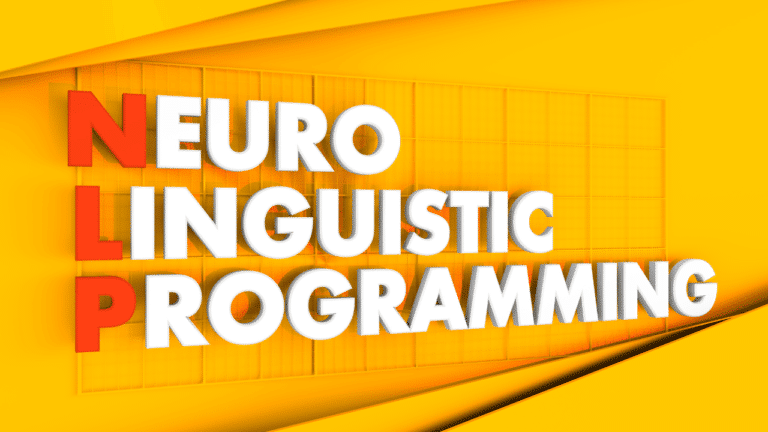In the realm of personal development, Neuro-Linguistic Programming (NLP) or NLP Techniques offers a powerful set of techniques and strategies for self-improvement. By understanding the relationship between our thoughts, language, and behaviors, NLP empowers individuals to transform limiting beliefs, overcome obstacles, and achieve personal growth. In this article, we will explore some effective NLP techniques that can help you embark on a journey of self-improvement and unlock your full potential.

- Anchoring : Anchoring is a fundamental NLP technique that allows you to associate a specific state of mind or emotion with a particular stimulus. To begin, identify a positive emotional state you want to anchor, such as confidence or motivation. Then, choose a physical anchor, such as squeezing your fist or touching your thumb and forefinger together. Recall a vivid memory where you experienced the desired state, intensifying the associated emotions. While in that heightened state, activate your chosen anchor. Repeat this process several times to reinforce the anchor, so you can trigger the desired state whenever you need it. Anchoring empowers you to access resourceful states at will, enabling you to face challenges with confidence and maintain motivation in pursuit of your goals.
- Reframing: Reframing is a powerful NLP technique that involves shifting your perspective on a situation to change your emotional response and interpretation. Begin by identifying a situation that causes negative emotions or triggers limiting beliefs. Challenge your current interpretation by asking yourself empowering questions, such as “What can I learn from this?” or “How can I turn this into an opportunity?” By reframing the situation, you open yourself up to new possibilities and alternative perspectives. Focus on the positive aspects or potential growth that the situation offers. Reframing empowers you to transform challenges into opportunities for personal development, allowing you to overcome obstacles and achieve your goals with a renewed sense of purpose.
- Visualizations: Visualizations are powerful tools in NLP for self-improvement. Create a mental image of yourself achieving a specific goal or desired outcome. Engage all your senses to make the visualization vivid and compelling. See yourself succeeding, hear the sounds associated with your achievement, feel the emotions of accomplishment, and even imagine the scent or taste of victory. By consistently visualizing your goals, you reprogram your subconscious mind, increase motivation, and align your actions with your desired outcomes. Visualizations not only provide clarity and focus but also inspire and energize you to take the necessary steps towards achieving your aspirations.
- Belief Change: Our beliefs shape our reality, and NLP offers techniques to transform limiting beliefs into empowering ones. Begin by identifying a belief that holds you back from reaching your full potential. Examine the evidence supporting and contradicting that belief. Challenge the validity of the limiting belief by questioning its source and exploring alternative perspectives. Replace the limiting belief with a positive affirmation or empowering belief that aligns with your goals and aspirations. Create a powerful statement that resonates with you and evokes positive emotions. Repeat these affirmations daily to rewire your subconscious mind and reinforce the new belief system. By consciously changing your beliefs, you open yourself up to new possibilities and experiences, empowering yourself to overcome challenges and achieve personal growth.
- Language Patterns: Language is a powerful tool in NLP for self-improvement. Pay attention to your internal and external dialogue, and use empowering language patterns. Instead of saying, “I can’t,” rephrase it as, “How can I?” or “What resources do I need to?” Use positive and solution-oriented strategies language to communicate with yourself and others. By adopting empowering language patterns, you shift your mindset, focus on possibilities, and open yourself up to new opportunities for growth and improvement. By consciously choosing your words, you reframe your thoughts and beliefs, creating a positive and empowering internal dialogue that supports your self-improvement journey.
- Goal Setting (200 words): NLP provides a structured approach to goal setting for self-improvement. Utilize the SMART (Specific, Measurable, Achievable, Relevant, Time-bound) framework to set clear and actionable goals. Begin by clearly defining your desired outcome and ensure that it is specific, measurable, and relevant to your overall vision. Break down larger goals into smaller, achievable steps, and establish a timeline for each milestone. Visualize and emotionally connect with the successful accomplishment of your goals, allowing yourself to experience the joy and satisfaction of achievement. Continuously review and adjust your goals as necessary to maintain alignment with your evolving aspirations. By applying NLP techniques to goal setting, you enhance motivation, maintain focus, and track your progress effectively, thus propelling yourself forward on your self-improvement journey.
Conclusion: Neuro-Linguistic Programming offers a treasure trove of techniques for self-improvement, enabling individuals to unleash their full potential. Through the use of anchoring, reframing, visualizations, belief change, language patterns, and goal setting, you can cultivate a positive mindset, overcome obstacles, and achieve personal growth. Embrace these NLP techniques, practice them consistently, and witness the transformative power they hold in helping you create the life you desire. Remember that self-improvement is an ongoing journey, and with NLP techniques as your tools, you can continuously evolve, surpass limitations, and unleash your full potential.

0 Comments